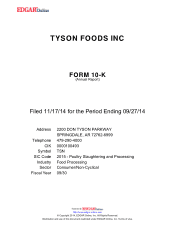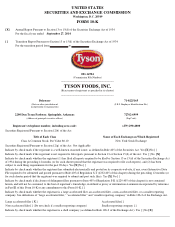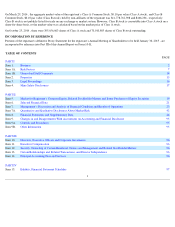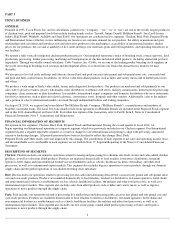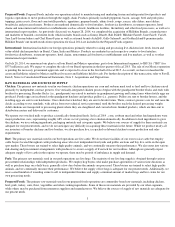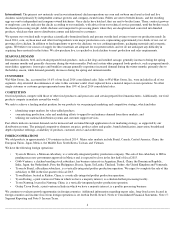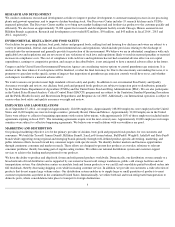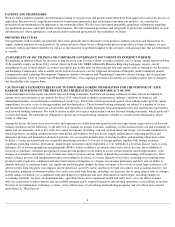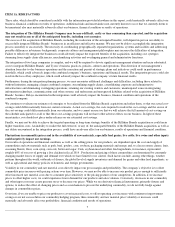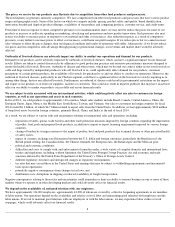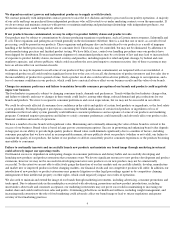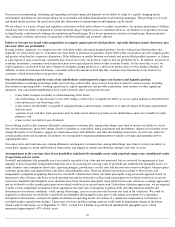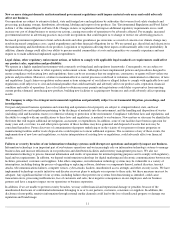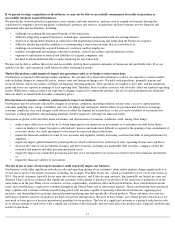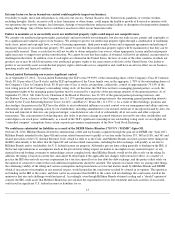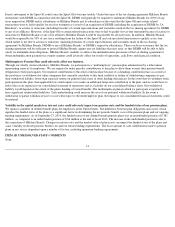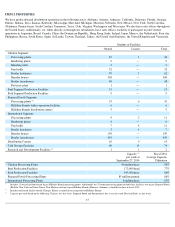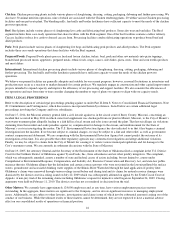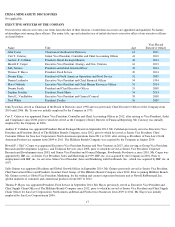Tyson Foods 2014 Annual Report Download - page 9
Download and view the complete annual report
Please find page 9 of the 2014 Tyson Foods annual report below. You can navigate through the pages in the report by either clicking on the pages listed below, or by using the keyword search tool below to find specific information within the annual report.
ITEM 1A. RISK FACTORS
These risks, which should be considered carefully with the information provided elsewhere in this report, could materially adversely affect our
business, financial condition or results of operations. Additional risks and uncertainties not currently known to us or that we currently deem to
be immaterial also may materially adversely affect our business, financial condition or results of operations.
The integration of The Hillshire Brands Company may be more difficult, costly or time consuming than expected, and the acquisition
may not result in any or all of the anticipated benefits, including cost synergies .
The success of the acquisition of Hillshire Brands, including the realization of the anticipated benefits, will depend in part on our ability to
successfully integrate Hillshire Brands’ businesses in an efficient and effective manner. We may not be able to accomplish this integration
process smoothly or successfully. The necessity of coordinating geographically separated organizations, systems and facilities and addressing
possible differences in business backgrounds, corporate cultures and management philosophies may increase the difficulties of integration.
Failure to effectively integrate the businesses could adversely impact the expected benefits of the acquisition, including cost synergies
stemming from supply chain efficiencies, merchandising activities and overlapping general and administrative functions.
The integration of two large companies is complex, and we will be required to devote significant management attention and incur substantial
costs to integrate Hillshire Brands’ and Tyson’s business practices, policies, cultures and operations. This diversion of our management’s
attention from day-to-day business operations and the execution and pursuit of strategic plans and initiatives could result in performance
shortfalls, which could adversely impact the combined company’s business, operations and financial results. The integration process could also
result in the loss of key employees, which could adversely impact the combined company’s future financial results.
Furthermore, during the integration planning process, we may encounter additional challenges and difficulties, including those related to,
without limitation, managing a larger combined company; streamlining supply chains, consolidating corporate and administrative
infrastructures and eliminating overlapping operations; retaining our existing vendors and customers; unanticipated issues in integrating
information technology, communications and other systems; and unforeseen and unexpected liabilities related to the acquisition of Hillshire
Brands’ business. Delays encountered in the integration could adversely impact the business, financial condition and operations of the
combined company.
We continue to evaluate our estimates of synergies to be realized from the Hillshire Brands acquisition and refine them, so that our actual cost-
savings could differ materially from our current estimates. Actual cost-savings, the costs required to realize the cost-savings and the source of
the cost-savings could differ materially from our estimates, and we cannot assure you that we will achieve the full amount of cost-savings on
the schedule anticipated or at all or that these cost-savings programs will not have other adverse effects on our business. In light of these
uncertainties, you should not place undue reliance on our estimated cost-savings.
Finally, we may not be able to achieve the targeted operating or long-term strategic benefits of the Hillshire Brands acquisition or could incur
higher transition costs. An inability to realize the full extent of, or any of, the anticipated benefits of the Hillshire Brands acquisition, as well as
any delays encountered in the integration process, could have an adverse effect on our business, results of operations and financial condition.
Fluctuations in commodity prices and in the availability of raw materials, especially feed grains, live cattle, live swine and other inputs
could negatively impact our earnings.
Our results of operations and financial condition, as well as the selling prices for our products, are dependent upon the cost and supply of
commodities and raw materials such as pork, beef, poultry, corn, soybean, packaging materials and energy and, to a lesser extent, cheese, fruit,
seasoning blends, flour, corn syrup, corn oils, butter and sugar. Corn, soybean meal and other feed ingredients, for instance, represented
roughly 68% of our cost of growing a live chicken in fiscal 2014 . Production and pricing of these commodities are determined by constantly
changing market forces of supply and demand over which we have limited or no control. Such factors include, among other things, weather
patterns throughout the world, outbreaks of disease, the global level of supply inventories and demand for grains and other feed ingredients, as
well as agricultural and energy policies of domestic and foreign governments.
Volatility in our commodity and raw material costs directly impact our gross margin and profitability. The company’s objective is to offset
commodity price increases with pricing actions over time. However, we may not be able to increase our product prices enough to sufficiently
offset increased raw material costs due to consumer price sensitivity or the pricing postures of our competitors. In addition, if we increase
prices to offset higher costs, we could experience lower demand for our products and sales volumes. Conversely, decreases in our commodity
and other input costs may create pressure on us to decrease our prices. While we use derivative financial instruments, primarily futures and
options, to reduce the effect of changing prices and as a mechanism to procure the underlying commodity, we do not fully hedge against
changes in commodities prices.
Over time, if we are unable to price our products to cover increased costs, to offset operating cost increases with continuous improvement
savings or are not successful in our commodity hedging program, then commodity and raw material price volatility or increases could
materially and adversely affect our profitability, financial condition and results of operations.
7

